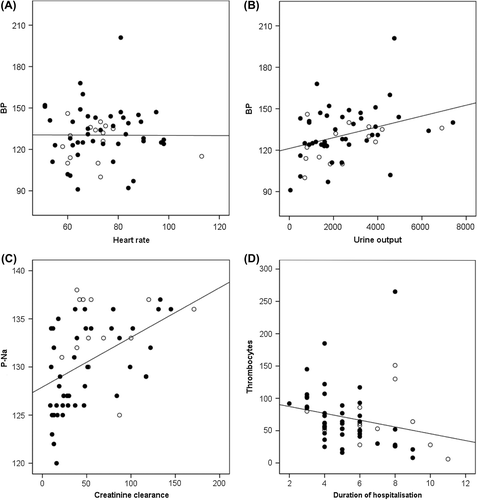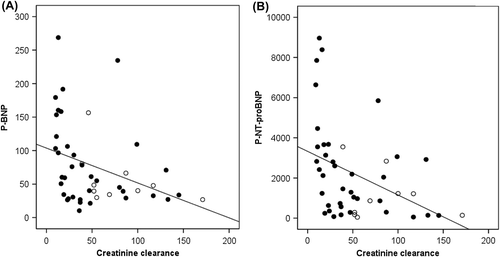Figures & data
Table I. A: Summary of selected general parameters which may indicate the severity of the acute nephropathia epidemica. Mean age, gender distribution, duration of hospitalization, maximum plasma creatinine, minimum creatinine clearance, minimum thrombocyte count, maximum C-reactive protein, cerebrospinal fluid (CSF)/serum albumin ratio, weight change during the period of hospitalization, and presence of pleural effusion in chest radiograph are shown. These clinical and laboratory parameters are divided according to plasma BNP and NT-proBNP (pg/mL) normal values. The statistical significance is shown. B: Summary of acute clinical and laboratory parameters which were measured when the BNP and NT-proBNP samples were collected. Systolic blood pressure, heart rate, urine output during the day the NP samples were collected, plasma creatinine, creatinine clearance, plasma sodium, plasma potassium, thrombocyte count, blood haemoglobin, haematocrit, and C-reactive protein. Correlation with the plasma BNP and NT-proBNP levels and the statistical significance are shown.
Figure 1. A: Summary of the patients’ heart rate (beats per minute) and systolic blood pressure measured when the NP samples were collected (BP, mmHg) is shown (no statistical correlation). B: The systolic blood pressure measured when the NP samples were taken displayed a correlation (r = 0.38, P < 0.01) with amount of urine collected over a 24-hour period (mL). C: Patients with low creatinine clearance (mL/min) were hyponatraemic (r = 0.47, P <0.000). D: The correlation (r = –0.41, P = 0.01) between the lowest measurement of blood thrombocyte count (× 109/L) and the duration of hospitalization is shown. Solid symbol: male; open circle: female.


